Jan 30, 2006
Presence 14:6 Now Available
Special Section:
Legal, Ethical, and Policy Issues Associated with Virtual Environments and Computer Mediated Reality
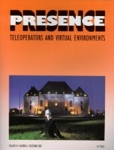
Articles
Sousveillance and Cyborglogs: A 30-Year Empirical Voyage through Ethical, Legal, and Policy Issues
Steve Mann
Buddy Bots: How Turing's Fast Friends are Undermining Consumer Privacy
Ian R. Kerr and Marcus Bornfreund
The Philosophy of Presence: From Epistemic Failure to Successful Observation
Luciano Floridi
Some Practical Considerations of Ethical Issues in VR Research
Katharina-Maria Behr, Andreas Nosper, Christoph Klimmt and Tilo Hartmann
Evaluation of a Haptic Mixed Reality System for Interactions with a Virtual Control Panel
Christoph W. Borst and Richard A. Volz
Leaving the World Behind: Supporting Group Collaboration Patterns in a Shared Virtual Environment for Product
Design John M. Linebarger, Christopher D. Janneck and G. Drew Kessler
Feedback Strategies for Telemanipulation with Shared Control of Object Handling Forces
Weston B. Griffin, William R. Provancher and Mark R. Cutkosky
Virtual Environment Training Therapy for Arm Motor Rehabilitation
Lamberto Piron, Paolo Tonin, Francesco Piccione, Vincenzo Iaia, Elena Trivello and Mauro Dam
Forum Issues of Law for Software Agents Within Virtual Environments
Woodrow Barfield
21:10 Posted in Telepresence & virtual presence | Permalink | Comments (0) | Tags: Positive Technology, Presence
Jan 27, 2006
Presence 2006
From the conference's website
Academics and practitioners with an interest in the concept of (tele)presence are invited to submit their work for presentation at PRESENCE 2006 at Cleveland State University in Cleveland, Ohio, August 24-26, 2006.
The ninth in a series of highly successful international workshops, PRESENCE 2006 will provide an open discussion forum to share ideas regarding concepts and theories, measurement techniques, technology, and applications related to presence, the psychological state or subjective perception in which a person fails to accurately and completely acknowledge the role of technology in an experience, including the sense of 'being there' experienced by users of advanced media such as virtual reality.
The concept of presence has been the focus of increasing scholarly attention since at least Minsky's "Telepresence" in 1980. Recently there has been a burst of funded research activity in this area with the European FET Presence Research initiative. What do we really know about presence and its determinants? How can presence be successfully delivered with today's technology? This conference invites papers that are based on empirical results from studies of presence and related issues and/or that make substantial advances in theoretical understanding of presence and/or that contribute to the technology for the delivery of presence. High quality papers which make substantial contributions to the field are sought; submissions will be rigorously evaluated by peer reviewers.
Work accepted for presentation will be included in the official conference proceedings and posted on the ISPR web site. Some of the presented papers will be selected for publication in one or more special issues of CyberPsychology & Behavior or Presence: Teleoperators and Virtual Environments.
PRESENCE 2006 takes place in Cleveland and is hosted by Cleveland State University. The conference is organized by ISPR, the International Society for Presence Research.
15:30 Posted in Telepresence & virtual presence | Permalink | Comments (0) | Tags: Positive Technology, Presence
Jan 03, 2006
A Science of the Divine?
Via Smart mobs
Prompted by Edge, Cognitive neuroscientist Stephen Kosslyn offers a set of hypotheses concerning a scientific theory of God

Here's an idea that many academics may find unsettling and dangerous: God exists. And here's another idea that many religious people may find unsettling and dangerous: God is not supernatural, but rather part of the natural order. Simply stating these ideas in the same breath invites them to scrape against each other, and sparks begin to fly. To avoid such conflict, Stephen Jay Gould famously argued that we should separate religion and science, treating them as distinct "magisteria." But science leads many of us to try to understand all that we encounter with a single, grand and glorious overarching framework. In this spirit, let me try to suggest one way in which the idea of a "supreme being" can fit into a scientific worldview.
I offer the following not to advocate the ideas, but rather simply to illustrate one (certainly not the only) way that the concept of God can be approached scientifically.
1.0. First, here's the specific conception of God I want to explore: God is a "supreme being" that transcends space and time, permeates our world but also stands outside of it, and can intervene in our daily lives (partly in response to prayer).
2.0. A way to begin to think about this conception of the divine rests on three ideas:
2.1. Emergent properties. There are many examples in science where aggregates produce an entity that has properties that cannot be predicted entirely from the elements themselves. For example, neurons in large numbers produce minds; moreover, minds in large numbers produce economic, political, and social systems.
2.2. Downward causality. Events at "higher levels" (where emergent properties become evident) can in turn feed back and affect events at lower levels. For example, chronic stress (a mental event) can cause parts of the brain to become smaller. Similarly, an economic depression or the results of an election affect the lives of the individuals who live in that society.
2.3. The Ultimate Superset. The Ultimate Superset (superordinate set) of all living things may have an equivalent status to an economy or culture. It has properties that emerge from the interactions of living things and groups of living things, and in turn can feed back to affect those things and groups.
3.0. Can we conceive of God as an emergent property of all living things that can in turn affect its constituents? Here are some ways in which this idea is consistent with the nature of God, as outlined at the outset.
3.1. This emergent entity is "transcendent" in the sense that it exists in no specific place or time. Like a culture or an economy, God is nowhere, although the constituent elements occupy specific places. As for transcending time, consider this analogy: Imagine that 1/100th of the neurons in your brain were replaced every hour, and each old neuron programmed a new one so that the old one's functionality was preserved. After 100 hours your brain would be an entirely new organ — but your mind would continue to exist as it had been before. Similarly, as each citizen dies and is replaced by a child, the culture continues to exist (and can grow and develop, with a "life of its own"). So too with God. For example, in the story of Jacob's ladder, Jacob realizes "Surely the Lord is in this place, and I did not know it." (Genesis 28: 16) I interpret this story as illustrating that God is everywhere but nowhere. The Ultimate Superset permeates our world but also stands outside of (or, more specifically, "above") it.
3.2. The Ultimate Superset can affect our individual lives. Another analogy: Say that geese flying south for the winter have rather unreliable magnetic field detectors in their brains. However, there's a rule built into their brains that leads them to try to stay near their fellows as they fly. The flock as a whole would navigate far better than any individual bird, because the noise in the individual bird brain navigation systems would cancel out. The emergent entity — the flock — in turn would affect the individual geese, helping them to navigate better than they could on their own.
3.3. When people pray to the Lord, they beseech intervention on their or others' behalf. The view that I've been outlining invites us to think of the effects of prayer as akin to becoming more sensitive to the need to stay close to the other birds in the flock: By praying, one can become more sensitive to the emergent "supreme being." Such increased sensitivity may imply that one can contribute more strongly to this emergent entity.
By analogy, it's as if one of those geese became aware of the "keep near" rule, and decided to nudge the other birds in a particular direction — which thereby allows it to influence the flock's effect on itself. To the extent that prayer puts one closer to God, one's plea for intervention will have a larger impact on the way that The Ultimate Superset exerts downward causality. But note that, according to this view, God works rather slowly. Think of dropping rocks in a pond: it takes time for the ripples to propagate and eventually be reflected back from the edge, forming interference patterns in the center of the pond.
4.0. A crucial idea in monotheistic religions is that God is the Creator. The present approach may help us begin to grapple with this idea, as follows.
4.1. First, consider each individual person. The environment plays a key role in creating who and what we are because there are far too few genes to program every aspect of our brains. For example, when you were born, your genes programmed many connections in your visual areas, but did not specify the precise circuits necessary to determine how far away objects are. As an infant, the act of reaching for an object tuned the brain circuits that estimate how far away the object was from you.
Similarly, your genes graced you with the ability to acquire language, but not with a specific language. The act of acquiring a language shapes your brain (which in turn may make it difficult to acquire another language, with different sounds and grammar, later in life). Moreover, cultural practices configure the brains of members of the culture. A case in point: the Japanese have many forms of bowing, which are difficult for a Westerner to master relatively late in life; when we try to bow, we "bow with an accent."
4.2. And the environment not only played an essential role in how we developed as children, but also plays a continuing role in how we develop over the course of our lives as adults. The act of learning literally changes who and what we are.
4.3. According to this perspective, it's not just negotiating the physical world and sociocultural experience that shape the brain: The Ultimate Superset — the emergent property of all living things — affects all of the influences that "make us who and what we are," both as we develop during childhood and continue to learn and develop as adults.
4.4. Next, consider our species. One could try to push this perspective into a historical context, and note that evolution by natural selection reflects the effects of interactions among living things. If so, then the emergent properties of such interactions could feed back to affect the course of evolution itself.
In short, it is possible to begin to view the divine through the lens of science. But such reasoning does no more than set the stage; to be a truly dangerous idea, this sort of proposal must be buttressed by the results of empirical test. At present, my point is not to convince, but rather to intrigue. As much as I admired Stephen Jay Gould (and I did, very much), perhaps he missed the mark on this one. Perhaps there is a grand project waiting to be launched, to integrate the two great sources of knowledge and belief in the world today — science and religion.
14:25 Posted in Telepresence & virtual presence | Permalink | Comments (0) | Tags: Positive Technology, Presence
Dec 06, 2005
Understanding emotions in others: mirror neuron dysfunction in children with autism spectrum disorders
 To examine mirror neuron abnormalities in autism, high-functioning children with autism and matched controls underwent fMRI while imitating and observing emotional expressions. Although both groups performed the tasks equally well, children with autism showed no mirror neuron activity in the inferior frontal gyrus (pars opercularis). Notably, activity in this area was inversely related to symptom severity in the social domain, suggesting that a dysfunctional 'mirror neuron system' may underlie the social deficits observed in autism.
To examine mirror neuron abnormalities in autism, high-functioning children with autism and matched controls underwent fMRI while imitating and observing emotional expressions. Although both groups performed the tasks equally well, children with autism showed no mirror neuron activity in the inferior frontal gyrus (pars opercularis). Notably, activity in this area was inversely related to symptom severity in the social domain, suggesting that a dysfunctional 'mirror neuron system' may underlie the social deficits observed in autism.21:45 Posted in Telepresence & virtual presence | Permalink | Comments (0) | Tags: Positive Technology, Presence
Nov 01, 2005
Nature Insight: Sleep
Until the mid of 20th century, most people thought of sleep as a passive part of our daily lives. Now the body of evidence suggests that the brain is very active during sleep. 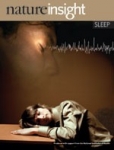 Moreover, neuroscience is beginning to understand the importance of sleep on our daily function and health.
Moreover, neuroscience is beginning to understand the importance of sleep on our daily function and health.
The current issue of Nature Insight, a supplement of the journal Nature, sheds fascinating light on cognitive neuroscience of sleep.
The supplement is freely available online
11:35 Posted in Telepresence & virtual presence | Permalink | Comments (0) | Tags: Positive Technology, Presence
Oct 25, 2005
Neurobiology of the self on Scientific American
Via Brain Blog
The November 2005 issue of Scientific American publishes an article by Carl Zimmer entitled "The Neurobiology of the Self". This is the abstract:
The most obvious thing about yourself is your self. "You look down at your body and know it's yours," says Todd Heatherton, a psychologist at Dartmouth University. "You know it's your hand you're controlling when you reach out. When you have memories, you know that they are yours and not someone else's. When you wake up in the morning, you don't have to interrogate yourself for a long time about who you are." The self may be obvious, but it is also an enigma. Heatherton himself shied away from direct study of it for years, even though he had been exploring self-control, self-esteem and other related issues since graduate school. "My interests were all around the self but not around the philosophical issue of what is the self," he explains. "I avoided speculations about what it means. Or I tried to, anyway."
16:15 Posted in Telepresence & virtual presence | Permalink | Comments (0) | Tags: Positive Technology, Presence
Apr 06, 2005
Exploring the frontier of telepresence
By Geoff McMaster, ExpressNews Staff - The closest many of us have come to imagining virtual reality is the holodeck, a fantasy playground featured on the television series Star Trek.
Such flights of fancy are no longer the stuff of science fiction, however. Computer scientists at the U of A have already created technology allowing people to sit across from three-dimensional recreations of each other, even though in reality they may be thousands of miles apart.
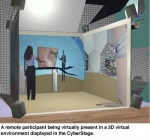
It's only the beginning of a revolution in virtual reality technology expected to take us by storm in the next decade or so, says Dr. Pierre Boulanger, a U of A computer scientist who just received an iCORE/TRLabs Industrial Research Chair worth a total of $1.7 million to develop his groundbreaking work in collaborative virtual environments.
Imagine a world, for example, where professors of surgery transmit hand and scalpel movements, as well as what they see while operating, thousands of miles across a computer network, where it is recreated in an operating room.
"The student will actually look at that and actually feel what the doctor is doing," said Boulanger. "On the other hand, the doctor can feel what the students are doing and give them a nudge in the right direction--It's like being in virtual residence with doctors."
Families separated by travel will spend meals together through what is called "telepresence," said Boulanger. "You would wear special goggles--and we're working on that--which would allow you to see your wife sitting in front of you, having a day-to-day conversation. In the future you will have virtual encounters like this, people you want to be part of a meeting sitting beside you virtually and having a conversation."
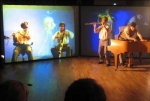
At a press conference on campus Tuesday to celebrate his chair, and that of Dr. Christoph Sensen at the University of Calgary, Boulanger explained how scientists are now able to create and manipulate a model of the earth's core by feeding computers highly sophisticated mathematical equations. Once recreated in 3D, the average person is fully capable of understanding such complex physical phenomena, he said. "People can actually interact with it, and say, "What happens if we have that instead of this?'"
"A three-dimensional visual model will allow you to explain complex systems, and understand how the world runs. People understand complex systems because daily life is actually very complex--the new technology is truly human-centred. Computers are smart enough today to adapt to people, and that's really a recent shift in computing."
The two chairs held by Boulanger and Sensen will focus on a variety of pursuits that will benefit from virtual reality technology, including engineering prototypes, testing medical procedures and conducting scientific research. Sensen, who has received $1 million for his research, is developing new tools to virtually work in the human body.
Boulanger was recruited to the University of Alberta's computing science department in 2001 from the National Research Council of Canada, where he spent 18 years as a senior research officer. He is also an adjunct scientist and principal investigator for new media at TRLabs, Canada's largest not-for-profit information and communications technology research consortium , and at the Banff Centre.
His new chair includes an iCORE Industrial Chair Establishment grant of $50,000 per year for five years, in addition to further grants from TRLabs, the University of Alberta, the Canada Foundation for Innovation, the Natural Sciences and Engineering Research Council, the Canadian Network for the Advancement of Research in Industry and Education and other industry partners.
"From my perspective, an absolutely essential part of Pierre's work on the collaborative virtual environment is described by the word collaborative," said dean of science Gregory Taylor. "It's at the very forefront of what I like to call the new science, interdisciplinary science where the collaborative team becomes the vehicle for discovery."
iCORE was established six years ago by the provincial government to support university research that supports information and communications technology. There are now 20 chairs focused on emerging areas such as wireless communications, artificial intelligence and quantum nanocomputing
15:45 Posted in Telepresence & virtual presence | Permalink | Comments (0) | Tags: Positive Technology, Presence
Apr 04, 2005
New article about Presence published on Nature!
Maria V. Sanchez-Vives and Mel Slater have published a review article entitled "From Presence to Consciousness through Virtual Reality" on the prestigious journal Nature Neuroscience (ASI impact factor 2003: 27.007).

In this article, the authors argue that presence - the sense of "being there" perceived during the exploration of a virtual environment - is worthy of study by neuroscientists, and that it might aid the study of perception and consciousness.
Maria V. Sanchez-Vives, Mel Slater, From Presence to Consciousness through Virtual Reality, Nature Reviews Neuroscience 6, 332-339 (2005); doi:10.1038/nrn1651
12:15 Posted in Telepresence & virtual presence | Permalink | Comments (0) | Tags: Positive Technology, Presence
Dec 29, 2004
Charles Tart: Virtual Reality & Altered States of Consciousness
The link between VR and altered states of consciousness is an interesting one. One of the first researchers that have discussed this relationship is Charles Tart. According to Tart, VR can be considered a new technological model of consciousness. In particular, he suggests that "stable patterns, stabilized systems of these internal virtual realities, constitute states of consciousness, our ordinary personality, and multiple personalities"
Of particular interest is Tart's explanation of the feeling of being "present" in a computer-generated world, although in its article he doesn't use the word presence. He suggests that presence emerges from a core psychological pattern which "automatically organizes the rest of experience around itself in a way that further supports the basic pattern". He thinks that this is the same process of perceiving a constellation. A constallation is not "real", because the spatial distribution of visible stars is random. However, once a pattern has organized, it is hard not to perceive it that way.
If you want to read more about Tart's theory of virtual reality, read these online articles:
Multiple Personality, Altered States and Virtual Reality: The World Simulation Process Approach
(This is the published version of the paper, which appeared as "Multiple Personality, Altered States and Virtual Reality: The World Simulation Process Approach" in the journal, "Dissociation," Vol. 3, 222-233)
Mind Embodied! Computer-Generated Virtual Reality as a New, Dualistic-Interactive Model for Transpersonal Psychology
(Based on a speech given at the L. E. Rhine Centenary Conference on Cultivating Consciousness for Enhancing Human Potential, Wellness and Healing, Durham, North Carolina, November 9, 1991. A modified version was later published in K. Rao (Editor), "Cultivating Consciousness: Enhancing Human Potential, Wellness and Healing." Westport, Connecticut: Praeger, 1993. Pp. 123-137.)
02:15 Posted in Telepresence & virtual presence | Permalink | Comments (0) | Tags: Positive Technology, Presence
Dec 23, 2004
Presence 13:5 Now Available
The first journal for serious investigators of teleoperators and virtual environments, incorporating perspectives from physics to philosophy. 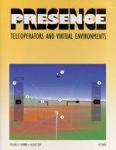 Vol. 13, Issue 5 - October 2004 Articles Article available as PDFSAMPLE ARTICLE - FREELY AVAILABLE!The Role of Graphical Feedback About Self-Movement when Receiving Objects in an Augmented Environment Andrea H. Mason and Christine L. MacKenzie Haptic Interfaces for Wheelchair Navigation in the Built Environment Colin S. Harrison, Mike Grant and Bernard A. Conway Exploring the Roles of Information in the Manual Control of Vehicular Locomotion: From Kinematics and Dynamics to Cybernetics Max Mulder, René van Paassen and Erwin Boer The Importance of Stereo and Eye Coupled Perspective for Eye-Hand Coordination in Fish Tank VR Roland Arsenault and Colin Ware Does the Quality of the Computer Graphics Matter when Judging Distances in Visually Immersive Environments? William B. Thompson, Peter Willemsen, Amy A. Gooch, Sarah H. Creem-Regehr, Jack M. Loomis and Andrew C. Beall Limited Field of View of Head-Mounted Displays Is Not the Cause of Distance Underestimation in Virtual Environments Joshua M. Knapp and Jack M. Loomis An Independent Visual Background Reduced Simulator Sickness in a Driving Simulator Henry Been-Lirn Duh, Donald E. Parker and Thomas A. Furness Toward Systematic Control of Cybersickness Marshall B. Jones, Robert S. Kennedy and Kay M. Stanney Postural Responses to Two Technologies for Generating Optical Flow Thomas A. Stoffregen, Benoît G. Bardy, Omar A. Merhi and Olivier Oullier [ More on Vol. 13, Issue 5 - October 2004 | Presence: Teleoperators and Virtual Environments Home Page | Presence: Teleoperators and Virtual Environments Orders and Renewals ]
Vol. 13, Issue 5 - October 2004 Articles Article available as PDFSAMPLE ARTICLE - FREELY AVAILABLE!The Role of Graphical Feedback About Self-Movement when Receiving Objects in an Augmented Environment Andrea H. Mason and Christine L. MacKenzie Haptic Interfaces for Wheelchair Navigation in the Built Environment Colin S. Harrison, Mike Grant and Bernard A. Conway Exploring the Roles of Information in the Manual Control of Vehicular Locomotion: From Kinematics and Dynamics to Cybernetics Max Mulder, René van Paassen and Erwin Boer The Importance of Stereo and Eye Coupled Perspective for Eye-Hand Coordination in Fish Tank VR Roland Arsenault and Colin Ware Does the Quality of the Computer Graphics Matter when Judging Distances in Visually Immersive Environments? William B. Thompson, Peter Willemsen, Amy A. Gooch, Sarah H. Creem-Regehr, Jack M. Loomis and Andrew C. Beall Limited Field of View of Head-Mounted Displays Is Not the Cause of Distance Underestimation in Virtual Environments Joshua M. Knapp and Jack M. Loomis An Independent Visual Background Reduced Simulator Sickness in a Driving Simulator Henry Been-Lirn Duh, Donald E. Parker and Thomas A. Furness Toward Systematic Control of Cybersickness Marshall B. Jones, Robert S. Kennedy and Kay M. Stanney Postural Responses to Two Technologies for Generating Optical Flow Thomas A. Stoffregen, Benoît G. Bardy, Omar A. Merhi and Olivier Oullier [ More on Vol. 13, Issue 5 - October 2004 | Presence: Teleoperators and Virtual Environments Home Page | Presence: Teleoperators and Virtual Environments Orders and Renewals ]
01:05 Posted in Telepresence & virtual presence | Permalink | Comments (0) | Tags: Positive Technology, Presence







